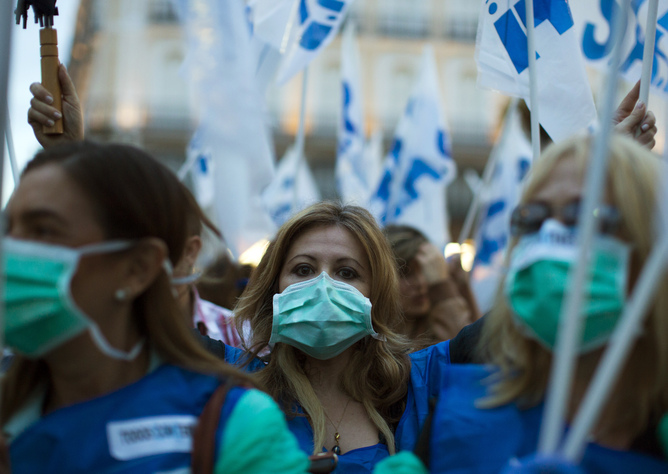
By Priscilla Wald, Duke University
It does not make the news when a two year old boy dies of Ebola in Guinea. Nor when his sister, his mother and his grandmother succumb. It takes time for local officials to recognize an outbreak. By the time it is international news, headlines spread panic.
As Ebola jumped from West Africa to the United States and Europe newspapers screamed, “Apocalypse” and compared Ebola to terrorism.
Some news stories give the facts and urge the public not to panic. Others forecast worst-case scenarios bordering on science fiction. Speculation: is the virus a result of bioterror spinning out of control? Could it be weaponized? And a slight shift: the virus itself is a “bioterrorist.”
These stories all conform to what I have called “the outbreak narrative.” I have chronicled the emergence of this prototypical story in efforts of researchers, doctors, epidemiologists and science writers to explain the catastrophic new infections – Ebola, Marburg, Bolivian Hemorrhagic Fever and HIV/AIDS. Most of these diseases have been identified since the 1960s, just as expanding global population and development initiatives found human beings moving into hitherto uninhabited spaces and encountering new microbes.
The outbreak narrative is a series of images, phrases, scenarios and story lines that unfold like so many movies. The events are real, but the narrative blurs fact and fiction. We are at war: man vs microbe.
Ebola is perfect for the outbreak narrative because it is dramatic both in its ravages and in its display of epidemiological heroism and the triumph of government policies and medical science.
A cycle of panic and stigma
During a crisis, the government’s immediate concerns are containment and treatment: border screenings, quarantine, pharmaceuticals and vaccines.
Precautions are wise, but the language of crisis quickly turns commonsense to panic. And panic has consequences. Big ones. People and places can be stigmatized and working assumptions about diseases can be difficult to dislodge.
For instance, the christening of HIV/AIDS as Gay-related Immunodeficiency (GRID) suggested a lead in the early years of the disease. But the assumptions contained in the acronym and the pressure for answers likely helped to obscure blood, hence the blood supply, as a means of transmission.
During the SARS epidemic dramatic headlines and news stories contributed to catastrophic financial losses in Toronto, Hong Kong and every other site of the outbreak. Even the anticipation of an outbreak — of avian flu, for example — can make an entire region seem like a seething hot zone: Asia: the ‘Perfect Incubator’; The Flimsy Wall of China; Nature’s Bioterrorist: Is There Any Way to Prevent a Deadly Avian-Flu Pandemic?.
This cycle of panic and stigma has repeated itself with Ebola. Following the death of Thomas Duncan in Dallas West Africans living in the US report incidents of being stigmatized. Two Rwandan schoolchildren have gone into voluntary quarantine because of parental panic (and ignorance of geography) in a New Jersey elementary school. And irrational fear has slackened business for a West African restaurant in Minnesota, possibly to the point of closure.
The outbreak narrative appeals because it sparks reassurance as well as fear in regions of the world with sufficient resources to address the problem.

European Commission DG ECHO/EC/ECHO/Cyprien Fabre/Flickr, CC BY-ND
Changing the narrative
The current Ebola epidemic offers another lesson: the reverse of panic is not calm, but complacency. If Ebola fuels panic now, we should remember that in the early days of the epidemic the World Health Organization and others could have done more to halt the spread of Ebola. Past outbreaks suggested a more containable threat than it has proved to be in West Africa, where the ravages of poverty quickly turned the outbreak into an epidemic. A faster response may have enabled a containment of the virus before it jumped continents.
Where is the balance? How should we think about outbreaks? There is a difference between urgency and crisis, informed caution and panic. And between short-term and long-term solutions. Faced with a pandemic, the government and medical responses are appropriate. But why aren’t we doing more to keep outbreaks from becoming pandemics?
The outbreak narrative is a crisis narrative, and crises demand short-term solutions. Yet, there is no greater vector for turning an outbreak into an epidemic, and an epidemic into a pandemic than poverty. Malnourished and without adequate shelter and access to health care, people living in poverty are more susceptible to illness. We need to address poverty, not stigmatize the impoverished.
Directing resources to the problem of global poverty is a humanitarian concern. It is also a long-term commitment. The World Bank estimates that a severe epidemic of influenza could cost nearly US$3 trillion dollars, significantly more than it would cost to address the structural issues of global poverty that would contribute to a catastrophic pandemic. So why aren’t we doing so?
We need to start by telling the story of the threat differently. We need to replace the focus on survival with the question of how we should live in a global world.
We are all human. We are all susceptible. More importantly, we are all responsible.
![]()
Priscilla Wald does not work for, consult to, own shares in or receive funding from any company or organisation that would benefit from this article, and has no relevant affiliations.
This article was originally published on The Conversation.
Read the original article.




















